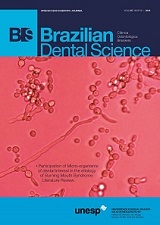Incomplete vertical root fracture associated with lateral compaction technique: a microscopic analysis
DOI:
https://doi.org/10.14295/bds.2013.v16i2.894Abstract
Objective:This study evaluated the effects of root canal obturation employing lateral compaction technique and spreader load of 1.5 kg on the incidence of complete (CVRF) or incomplete vertical root fractures (IVRF). Material and Methods: Twenty-seven distal roots of extracted human mandibular molars were used. All root canals were prepared by biomechanical step-back technique and obturated by lateral compaction technique. The prepared roots were distributed into two groups: G1- experimental (n=17) and G2- control (n=10). During obturation, load of 1.5 kg was applied to a size 30 finger spreader. Pre- and post-obturation images of the coronal portion of the roots were captured by inverted digital microscopy and analyzed by one trained examiner. Data were evaluated by Fisher’s test (p < 0.05) using GrapH Pad Prism 5.0. Results: No roots exhibited CVRF. All fractures observed before and after obturation were IVRF or “other defects”. In G2 (control group), there was no increase of IVRF number. Interestingly, G1 presented an increase in the IVRF number to 70,59% in the 12 teeth out of 17 teeth studied. The statistical analysis showed that the mean of IVRF increased significantly in G1 when compared to G2 (p < 0.05). Conclusions: The application of a 1.5 kg spreader load during lateral compaction technique does not produce complete vertical root fractures, but may produce incomplete fractures or “other defects”.Downloads
Downloads
Additional Files
Published
How to Cite
Issue
Section
License
Brazilian Dental Science uses the Creative Commons (CC-BY 4.0) license, thus preserving the integrity of articles in an open access environment. The journal allows the author to retain publishing rights without restrictions.
=================




























